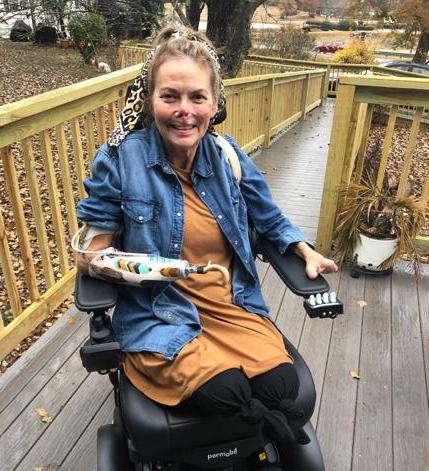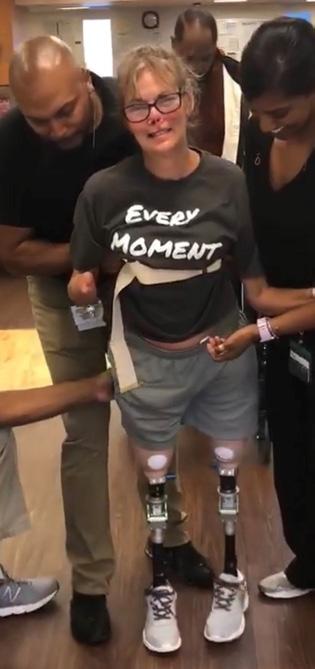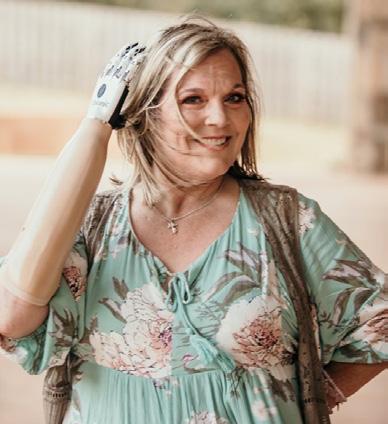
7 minute read
Patient Success Story:From Tragedy to Triumph
from AMRPA Magazine | May 2020
by AMRPA
Patient Success Story: Julie Guthrie and Kim Steel From Tragedy to Triumph
By Adam Robertson, AMRPA Marketing Communications Manager
AMRPA Seeking Member Submissions of Patient Success Stories and Testimonials
In 2020, AMRPA Magazine wants to feature you! We are currently soliciting patient success stories and testimonials from AMRPA member hospitals, to better showcase the outstanding work of our industry and membership. If you are interested in submitting a success story or testimonial, please visit https://amrpa.org/For-Patients/Patient-Success-Stories
Julie Guthrie
Faced with unexpected tragedies, both Julie Guthrie and Kim Steele suffered from sepsis and multi-organ failures that led to quadruple amputation. Lovers of life by nature and fighters by circumstance, these women confronted their grim situations head on.
Things may look a little different for them now, but with optimism, strength, unwavering hope and hard work at Roosevelt Warm Springs Rehabilitation Hospital, they have reclaimed their lives and their independence.
These are the stories of their inspirational and emotional journeys to recovery.
Julie Guthrie
“Float, float on. Float on, float on . . .”
For most, these are just lyrics that some recognize from the song “Float On” by The Floaters.
For Julie Guthrie, they will forever remind her of one of her most positive memories of the time she spent at Roosevelt Warm Springs Rehabilitation Hospital.
While she admitted she is not the best singer, she remembers the unforgettable laughs shared during an impromptu concert she had at the hospital’s gym with the rehab team – the same team that worked with her to reclaim her mobility and successfully use prostheses after her quadruple amputation.
“I had an extremely poor prognosis. Most people do not survive severe sepsis with multi-organ failure, and the ICU doctors told my daughters I had about a 30% chance of surviving.”
In just the first 48 hours of sepsis, she experienced kidney failure, liver failure and a heart attack.
But the complications did not stop there.
Julie also had disseminated intravascular coagulation (DIC), which prevented circulation to her extremities.
After spending a week in ICU on a ventilator and five full days on dialysis, she was faced with the most difficult decision of her life: undergo a quadruple amputation or be sent to hospice.
Told she may not even survive the surgery, it was at that very moment that she, along with the support of her daughters, decided to fight.
Two days later, surgeons amputated both of her legs above the knee, her right hand and all of her fingers and top of her thumb on her left hand.
“I truly do not think any of us thought I would make a full recovery, but once I survived through my amputation surgery, I think it became clear that I am not giving up and I will survive!”
When she arrived at Roosevelt, her dedicated team worked diligently to teach her how to successfully live a whole new lifestyle. What seemed impossible at first, like eating and bathing, soon become easy, and now Julie is able to independently water her flowers at home, put on makeup and even hold her “new grandson and love on him.”
And she will never forget when she put on her prosthetic legs for the first time and stood up. “I felt so tall,” she said, expressing her gratitude to her rehab team for helping her regain her strength and dexterity to even be ready to use her prosthetics.
“Rehab might sound scary to some after having such a major surgery such as amputation, but it was truly a life-changing experience for me. They ensured that I left there with all the necessary tools to live a successful life as an amputee.”
Julie’s life is not what it was before, but her experience has taught her a number of lessons that she wishes to pass on to others who may face a similar situation.
As The Floaters sing in their hit song, “Now, I like a woman who loves her freedom,” and Julie’s love for her ability to live a free, independent life even after a quadruple amputation is in no short supply.

Kim Steele

Kim Steele
Not many of us are brave enough to take part in adrenaline-inducing activities like snorkeling, zip lining and skydiving.
53-year-old Kim Steele is, however, and she does so as a quadruple amputee.
“You never know what you can do until you are faced with a tragedy.”
And that includes extreme sports, all part of a new bucket list that Kim has just gotten started on as a sepsis survivor.
In May of 2016, after four days of taking a new medication, she had a severe toxic reaction. She was rushed to the ER, and within 30 minutes, she coded three times.
She was then intubated and placed in coma, at which time she suffered multi-organ failure. She developed sepsis, which lead to septic shock. In order to save her vital organs, including her heart, brain and kidneys, doctors used medication that increases blood pressure by constricting peripheral vessels. Unfortunately, that led to a lack of blood supply and oxygen in her limbs, causing necrosis and gangrene of her limbs.
“My family was told that I had less than a 9% chance of surviving.”
But despite the odds, she did survive, fighting for her life at every point.
“I never thought I would recover until I realized that I had to fight if I wanted my life back.”
Shortly after, she underwent a quadruple amputation but made a full recovery from sepsis.
In November, she arrived at Roosevelt Warm Springs Rehabilitation Hospital, where she was started on a robust plan to restore her mobility and independence.
Kim first learned how to use her prosthetic hands, picking up blocks and beads, then hanging up clothes, cooking and taking care of her farm animals. Once she mastered use of her upper body, it was time to focus on walking.
It was the night before she was to take her first steps. She said, “I couldn’t sleep that night because of the anticipation of what this day was going to mean.”
Surrounded by the nurses, doctors and other patients all with tears of joy in their eyes, she took her first step on December 28, 2016, filming the dramatic moment, so she could send it as a video to surprise to her family.
Looking back to her first days of rehab, she said, “I thought I was literally going to die. I had never worked out so hard . . . but you find that inner strength and fight through it. And that is what I did!”
Now, more than three years later, Kim continues to share her optimism with others and express a love for life.
She regularly holds motivational speaking events and has published a book, advocating for sepsis awareness and communicating to not only those that have gone through a similar situation but to everyone that “we don’t always get to choose the circumstances that happen to us, but we do get to choose what comes next!”
Most importantly, Kim focuses on sharing this message that highlights sepsis awareness and life lessons that she has learned:
“Educate yourself of the signs and symptoms of sepsis, and don’t wait until it is too late. We have to fight to save lives and limbs. The challenge is to make sure that everyone in the health care system understands how to recognize the key symptoms and responds.
The human spirit is one of perseverance and courage that no one can take away. There are things that we can’t change, but, in the end, they end up changing us. We are all in this together! Be bold to live the life the way you want and never apologize for it. You can always take the road less traveled instead of a well-beaten path. If I can help individuals to overcome those obstacles and fears of intimidation, and concentrate on the things that they can do and give them back the life they should be living, my purpose in this second chance at this thing called life will be complete!
We all have the strength and resilience to appreciate what we have and who we are. Each one of us has the strength and determination to succeed. I am not what happened to me but what I have become.”
For more information on the life-changing services provided by Roosevelt Warm Springs Rehabilitation Hospital, visit their website.
Learn more about the #powerofmedicalrehab by visiting this page on AMRPA’s website and reading our other patient success stories, Challenging the Prognosis and Fighting for Mobility and An Impossible Embrace.









